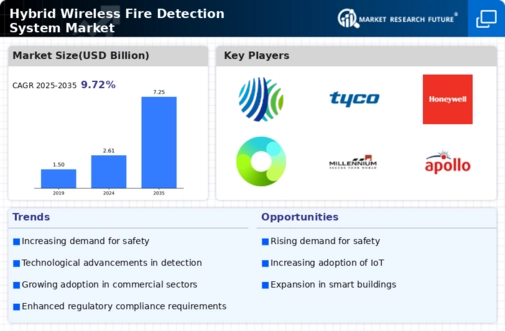Shift Towards Smart Building Solutions
The trend towards smart building solutions is reshaping the Hybrid Wireless Fire Detection System Market. As buildings become increasingly automated, the integration of fire detection systems with smart technologies is becoming essential. Hybrid wireless systems can seamlessly connect with other smart devices, enhancing overall building safety and operational efficiency. This integration allows for centralized monitoring and control, which is particularly appealing to facility managers. The market for smart building technologies is projected to grow significantly, with fire detection systems being a critical component. This shift indicates a promising future for hybrid wireless fire detection systems as part of comprehensive smart building solutions.
Rising Demand for Enhanced Safety Solutions
The increasing emphasis on safety in various sectors, including commercial, industrial, and residential, drives the Hybrid Wireless Fire Detection System Market. Organizations are prioritizing advanced fire detection systems to mitigate risks associated with fire hazards. This heightened focus on safety is reflected in the projected growth of the fire detection market, which is expected to reach USD 30 billion by 2026. The integration of hybrid wireless systems offers a more reliable and efficient solution, appealing to stakeholders who seek to enhance their safety protocols. As awareness of fire safety regulations grows, the demand for innovative detection systems is likely to rise, further propelling the Hybrid Wireless Fire Detection System Market.
Technological Advancements in Fire Detection
Technological innovations play a pivotal role in shaping the Hybrid Wireless Fire Detection System Market. The advent of advanced sensors, wireless communication technologies, and IoT integration has revolutionized fire detection systems. These advancements enable real-time monitoring and faster response times, which are crucial in emergency situations. The market is witnessing a shift towards systems that not only detect fires but also provide actionable insights through data analytics. As a result, the market for hybrid wireless fire detection systems is projected to grow at a CAGR of 12% over the next five years. This trend indicates a strong inclination towards adopting cutting-edge technologies in fire safety solutions.
Increased Awareness of Fire Safety Regulations
The growing awareness of fire safety regulations among businesses and homeowners significantly influences the Hybrid Wireless Fire Detection System Market. Regulatory bodies are implementing stricter fire safety standards, compelling organizations to upgrade their fire detection systems. Compliance with these regulations is not only a legal obligation but also a critical aspect of risk management. As a result, the demand for hybrid wireless fire detection systems is expected to surge, as they offer flexibility and ease of installation, making compliance more achievable. The market is likely to see a substantial increase in adoption rates as organizations strive to meet these evolving regulatory requirements.
Growing Investment in Infrastructure Development
The surge in infrastructure development across various sectors is a key driver for the Hybrid Wireless Fire Detection System Market. Governments and private entities are investing heavily in new construction projects, which necessitate the implementation of advanced fire safety measures. Hybrid wireless fire detection systems are particularly suited for large-scale projects due to their scalability and ease of installation. As urbanization continues to rise, the demand for effective fire detection solutions in new buildings is expected to increase. This trend suggests a robust growth trajectory for the hybrid wireless fire detection market, as stakeholders prioritize safety in their infrastructure investments.

















Leave a Comment